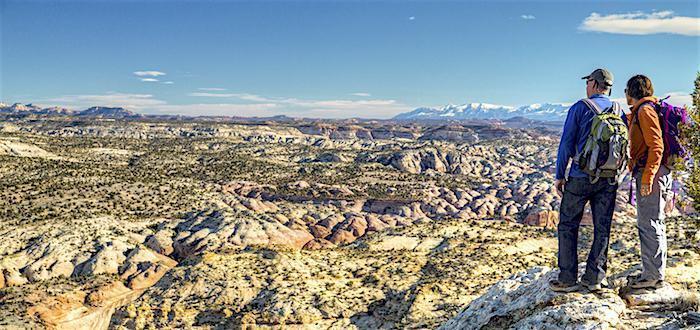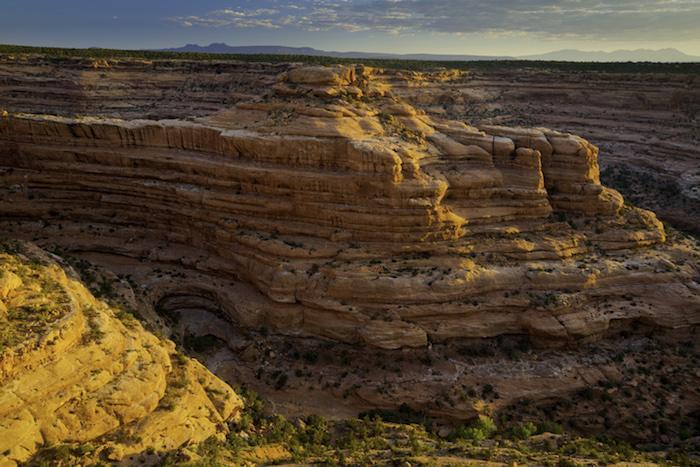
Who knows exactly what objects of curiosity, culture, and science lie across the Grand Staircase-Escalante National Monument?/BLM
Oftentimes it can be the little things, such as an inscription more than a century old chiseled into a boulder, or a yucca leaf, perhaps 1,000 years old, that had been chewed on one end to create a delicate brush for a shaman to paint images on cliff walls. And then, too, it can be large things, such as the nearly complete fossil of a tyrannosaur.
Those are some of the objects found on lands within Bears Ears and Grand Staircase-Escalante national monuments in southern Utah that President Trump is intent on dismantling. Although there are pending lawsuits that challenge the legitimacy of the president's proclamations made last month on the steps of Utah's Capitol, the U.S. Bureau of Land Management is moving forward to develop management plans that could allow mining within the original boundaries of the monuments.
And if the resulting plans do allow mining, what might happen to the "little things" and the "large things" that might be on those landscapes? Will field researchers be able to pinpoint them before mining possibly destroys them?
On Tuesday the BLM is expected to formally announce its intent to prepare Resource Management Plans for the two monuments. Or, rather, for the fragments of the two monuments that President Trump's action would create: Grand Staircase, Kaiparowits, and Escalante Canyon Units from the Grand Staircase-Escalante National Monument, and the Indian Creek and Shash Jáa Units of Bears Ears National Monument.
Along with considering oil and gas exploration and mining of other minerals within the three Grand Staircase units, the BLM intends to consider changes to off-highway vehicle routes and mining. "Parties interested in leasing and development of federal coal in areas that are excluded from the monument should provide coal resource data for their area(s) of interest," the document states.
Republican politicians in Utah, from the local level to the Statehouse and up to the congressional delegation, long sought ways to shrink the Grand Staircase-Escalante almost from the September day back in 1996 that President Clinton designated it. Driving much of their determination were the known coal reserves on the Kaiparowits Plateau, which covers about 1,650 square miles in southern Utah and touches not only the Grand Staircase-Escalante but also Glen Canyon National Recreation Area and Bryce Canyon National Park. A study by the U.S. Geological Survey estimated that about 28 billion tons of recoverable coal lies within the plateau.
Andelex Resources envisioned mining that coal for 40 years until Grand Staircase-Escalante was designated by President Clinton and that project was banned and the company's interests bought out by the Interior Department for $14 million.

Native American artifacts are among the rarities found within the Bears Ears National Monument/BLM, Bob Wick
The BLM's new planning document for the Bears Ears units was largely silent on mining, though it did note that the plan could involve, "where appropriate, split-estate lands where the subsurface mineral estate is managed by the BLM." In other words, if companies believed there were suitable recoverable minerals or energy deposits, the BLM could allow development.
During a conference call with reporters in December Interior Secretary Ryan Zinke said President Trump was not breaking up Bears Ears so oil and gas development could occur there. However, he didn't mention uranium mining, and on Sunday the New York Times reported that "even as Interior Secretary Ryan Zinke declared last month that 'there is no mine within Bears Ears,' there were more than 300 uranium mining claims inside the monument..."
The vast majority of those claims fall neatly outside the new boundaries of Bears Ears set by the administration. And an examination of local B.L.M. records, including those not yet entered into the agency’s land and mineral use authorizations database, shows that about a third of the claims are linked to Energy Fuels, a Canadian uranium producer. Energy Fuels also owns the Grand Canyon mine, where groundwater has already flooded the main shaft.
Energy Fuels, together with other mining groups, lobbied extensively for a reduction of Bears Ears, preparing maps that marked the areas it wanted removed from the monument and distributing them during a visit to the monument by Mr. Zinke in May.
Conservation groups that hope to overturn President Trump's actions in court were astounded by the BLM planning efforts.
“The BLM’s rush to act is irresponsible. No planning efforts should move forward until the legitimacy of these new proclamations and dismantling of protected areas are fully settled by the courts," said Phil Hanceford, The Wilderness Society's conservation director. "We fully expect these new proclamations to be overturned by the courts, making these planning efforts a colossal waste of time and money for an already strapped agency. The BLM should instead focus on using its money and staff resources protecting these monuments and the natural and cultural resources within them for current and future American generations.
"Rushing forward efforts to open up land monuments lands to drilling, mining, or irresponsible uses goes against the will of millions of Americans who spoke up and urged Interior Secretary Ryan Zinke and President Donald Trump to keep protections in place for our national treasures," he added. "Instead Zinke and his staff have turned their back on the rule of law and the wishes of a majority of Americans.”
On Sunday during a phone call Mr. Hanceford said no one has sought an injunction to halt any development before the matter can be fully litigated because so far there has been no active threat to the lands.
“To my knowledge, no party to the lawsuits has asked for a stay or an injunction. And I believe the reason being is you do need some kind of showing of imminent harm," he said. "So, for example, if we see mining claims being staked, or actions to actually lease the lands for coal or uranium, that would be an immediate or imminent harm that would call for an injunction. It’s tough to get a stay otherwise.”
The BLM's move forward is particularly perplexing, said Mr. Hanceford, as Congress has yet to formally pass legislation to enact what the president laid out in his proclamation.
"This is a rush job to ultimately be able to develop the resources that were excluded from the monument by the Trump order," he speculated.
That understood, The Wilderness Society staffer predicted it would take years for the matter to work its way through the legal system.
"I do expect the litigation to play out with appeals and everything else over the next several years," Mr. Hanceford said.
Meanwhile, a state to the west, in Nevada, the BLM supposedly has put off work on developing a management plan for Gold Butte National Monument, which President Obama designated and for which Interior Secretary Ryan Zinke has proposed some boundary changes involving five historic water district springs used by the local water district. While the BLM started the scoping process in December for the monument, earlier this month the Las Vegas Review-Journal reported that the planning has been halted.
“BLM did a complete about-face on the Gold Butte management plan, and the public deserves to know why,” said Patrick Donnelly, the Center for Bioliogical Diversity’s Nevada state director. “Our national monuments are under attack by the Trump administration. The least federal officials can do is be transparent about how these horrendous decisions are being made and who’s responsible.”



Comments
You can read the Federal Register notices announcing the new planning processes here:
Grand Staircase-Escalante: https://www.gpo.gov/fdsys/pkg/FR-2018-01-16/pdf/2018-00518.pdf
and Bears Ears here: https://www.gpo.gov/fdsys/pkg/FR-2018-01-16/pdf/2018-00520.pdf